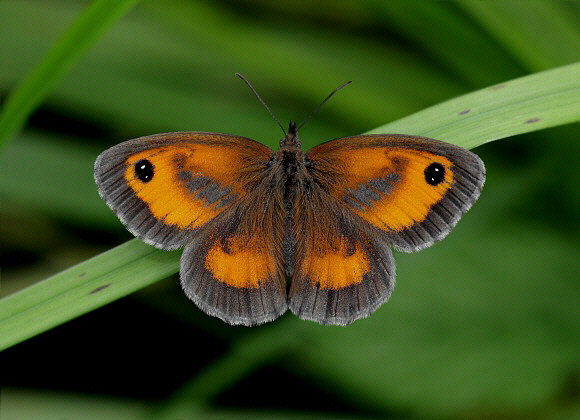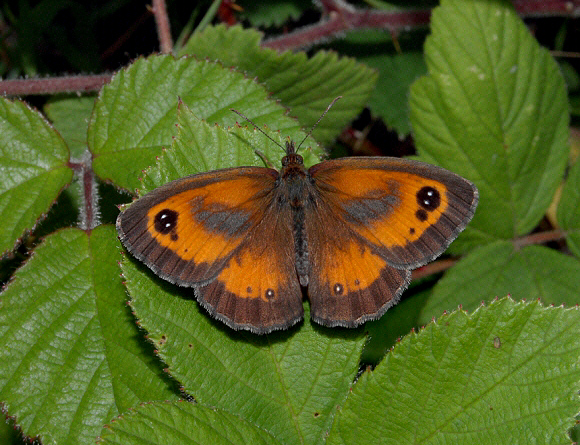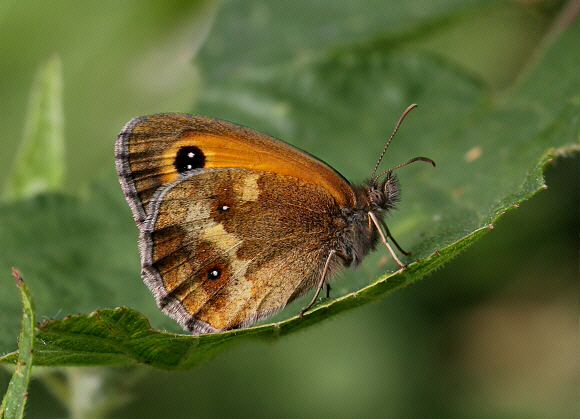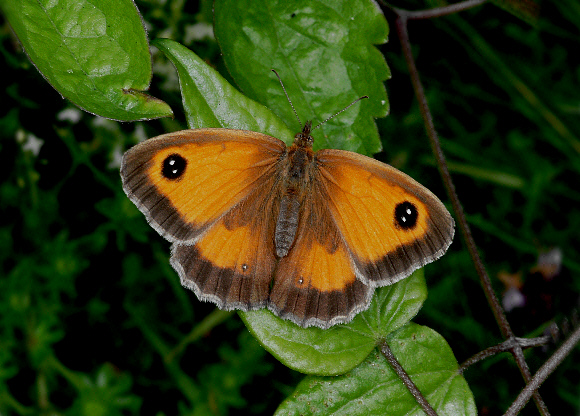 Gatekeeper Pyronia tithonus male, Waterperry Wood, Oxfordshire – Adrian Hoskins
Gatekeeper Pyronia tithonus male, Waterperry Wood, Oxfordshire – Adrian Hoskins
Introduction
The Gatekeeper is also known by the name Hedge Brown, and at various stages in history has been called ‘Small Meadow Brown’, ‘Hedge Eye’ and ‘Large Heath’ – the latter name now being applied to a different species Coenonympha tullia. For more information see British vernacular names.
This is a very common and widespread butterfly which is distributed throughout much of Europe but is absent from Scotland, Scandinavia and southern Italy. It is found in the Pyrenees, but is absent from the Alps, and from most Mediterranean islands. Beyond Europe it occurs in the Rif mountains of Morocco, and in western Turkey.
Male Gatekeepers have a prominent band of dark androconial scales running diagonally across the forewings, and are noticeably smaller than the females. Neither sex are prone to much variation in colour or patterning, although there can sometimes be a small third ocellus below the usual pair on the forewing.
 Pyronia tithonus, male ab multiocellata ( note additional spots on forewings ) – Adrian Hoskins
Pyronia tithonus, male ab multiocellata ( note additional spots on forewings ) – Adrian Hoskins
The Gatekeeper cannot be mistaken for any other British species, but both sexes are similar on the upperside to the Southern Gatekeeper P. cecilia, which occurs in Spain, Portugal, southern France, Italy and north Africa. The underside hindwings of the latter species are quite different, being dark brown, heavily mottled and striated with white.
Habitats
In southern England Gatekeepers can be found almost anywhere where grasses grow in association with bushes. They can be extremely common on scrubby grassland, in woodland clearings, scrubby heathland, sand dunes, and along railway cuttings, hedgerows and country lanes, always favouring sheltered sunny situations. In northern Britain however the butterfly is very rare. This pronounced north-south divide is probably controlled by the need for larvae to develop quickly during the spring and early summer when night temperatures in southern Britain are higher than in the north. It is also likely that parasite / host synchrony is climatically influenced, and this may affect the ability of the species to survive in northern areas.
The butterfly has become scarcer in areas where verge mowing, hedge removal and the misguided and obsessive ‘tidying up’ of the countryside has occurred. Nevertheless it is capable of recovering and recolonising habitats such as overgrown gardens, railway cuttings, quarries, and regenerating woodland clearings. At Broadmarsh in Hampshire for example it took about 5 years to colonise and become exceedingly common at a newly created coastal landfill site, having dispersed from a nearby large colony at Farlington Marshes.
 Gatekeeper Pyronia tithonus male, Wilton Brail, Wiltshire – Adrian Hoskins
Gatekeeper Pyronia tithonus male, Wilton Brail, Wiltshire – Adrian Hoskins
Lifecycle
The adults emerge in late June and July, and lay their eggs singly on grasses growing in sheltered and sunny positions at the base of hawthorn, bramble and blackthorn bushes where grasses grow quite tall and ungrazed. The eggs are spherical with about 16 vertical ridges. They are pale yellow when first laid, but soon develop irregular brown blotches. They hatch after about 14 days.
The larvae feed nocturnally on various grasses including red fescue Festuca rubra, meadow grass Poa pratensis, couch Agropyron repens, and bristle bent Agrostis setacea, eating only the finest leaf blades. In daytime they hide head-downwards at the base of grass tussocks. They enter hibernation in September when quite small, and re-awaken in March or April, feeding slowly and achieving full growth by late May or early June. The mature larva is dull greyish olive or sometimes a dirty buff colour, with a dark line along the back and thinner dark lines along the sides.
The chrysalis is a pale straw colour, marked on the wing cases and thorax with blackish streaks. It hangs by the cremaster, with the shrivelled larval skin still attached, from twigs or dry grass stems at the base of bushes. The pupal stage lasts about 2 weeks.
Adult behaviour
In overcast conditions, or in hazy sunshine, Gatekeepers bask on the foliage of bracken, bramble and other low vegetation. During sunny weather they flit from flower to flower, nectaring for a few seconds at a time at privet, bramble, dogwood, ragwort, fleabane, hemp agrimony, marjoram and various other plants.

Gatekeeper Pyronia tithonus, female, Stockbridge Down, Hampshire – Adrian Hoskins
Copulation takes place without any observed courtship ritual, and lasts for about an hour, during which the butterflies remain stationary with their wings closed.
